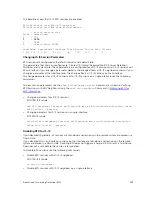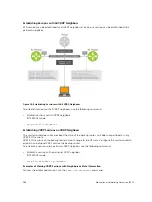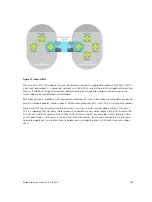
The bold line shows that IS-IS BFD sessions are enabled.
R2(conf-router_isis)#bfd all-neighbors
R2(conf-router_isis)#do show bfd neighbors
* - Active session role
Ad Dn - Admin Down
C - CLI
I - ISIS
O - OSPF
R - Static Route (RTM)
LocalAddr RemoteAddr Interface State Rx-int Tx-int Mult Clients
* 2.2.2.2 2.2.2.1 Te 2/1 Up 100 100 3 I
Changing IS-IS Session Parameters
BFD sessions are configured with default intervals and a default role.
The parameters that you can configure are: Desired TX Interval, Required Min RX Interval, Detection
Multiplier, and system role. These parameters are configured for all IS-IS sessions or all IS-IS sessions out
of an interface. If you change a parameter globally, the change affects all IS-IS neighbors sessions. If you
change a parameter at the interface level, the change affects all IS-IS sessions on that interface.
To change parameters for all IS-IS sessions or for IS-IS sessions on a single interface, use the following
commands.
To view session parameters, use the
show bfd neighbors detail
command, as shown in
Verifying
BFD Sessions with BGP Neighbors Using the
show bfd neighbors
Command
in
.
• Change parameters for all IS-IS sessions.
ROUTER-ISIS mode
bfd all-neighbors interval
milliseconds
min_rx
milliseconds
multiplier
value
role [active | passive]
• Change parameters for IS-IS sessions on a single interface.
INTERFACE mode
isis bfd all-neighbors interval
milliseconds
min_rx
milliseconds
multiplier
value
role [active | passive]
Disabling BFD for IS-IS
If you disable BFD globally, all sessions are torn down and sessions on the remote system are placed in a
Down state.
If you disable BFD on an interface, sessions on the interface are torn down and sessions on the remote
system are placed in a Down state. Disabling BFD does not trigger a change in BFD clients; a final Admin
Down packet is sent before the session is terminated.
To disable BFD sessions, use the following commands.
• Disable BFD sessions with all IS-IS neighbors.
ROUTER-ISIS mode
no bfd all-neighbors
• Disable BFD sessions with IS-IS neighbors on a single interface.
Bidirectional Forwarding Detection (BFD)
153
Summary of Contents for Z9000
Page 1: ...Dell Configuration Guide for the Z9000 System 9 7 0 0 ...
Page 80: ...grub reboot 80 Management ...
Page 128: ... 0 Te 1 1 Te 1 2 rx Flow N A N A 128 Access Control Lists ACLs ...
Page 491: ...Figure 70 Configuring OSPF and BGP for MSDP Multicast Source Discovery Protocol MSDP 491 ...
Page 496: ...Figure 73 MSDP Default Peer Scenario 1 496 Multicast Source Discovery Protocol MSDP ...
Page 497: ...Figure 74 MSDP Default Peer Scenario 2 Multicast Source Discovery Protocol MSDP 497 ...
Page 498: ...Figure 75 MSDP Default Peer Scenario 3 498 Multicast Source Discovery Protocol MSDP ...
Page 760: ...Figure 100 Single and Double Tag TPID Match 760 Service Provider Bridging ...
Page 761: ...Figure 101 Single and Double Tag First byte TPID Match Service Provider Bridging 761 ...
















































